Equi-note 22 Hyperflexion-rollkur damages the horse's visibility
The horse’s head position affects its ability to see
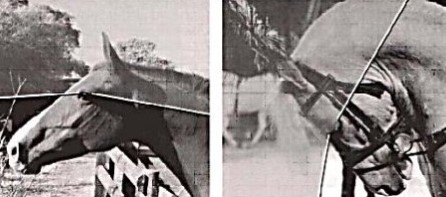
Source: photo on left El Sevier, wp: photo on right Captive Animals Protection Society; wp
Equi-note 22
Hyperflexion-rollkur damages the horse’s visibility
So far, the efffects of rollkur have been reviewed in terms of its physical effects on its body. However, there is another key aspect which involves the horse’s ability to see in front of itself. This is essential so that it can prepare itself properly for the challenge and consequence that it must face with every forward step.
The top image on the left shows the visual field in front of a horse when allowed to carry its head naturally, whiocih is virtyually horizontal. On the right shows the blind area in front of a horse when it is over-bent.
What does this mean in practical terms? The following photo shows what the horse sees in front of it when its nose is 90° to the ground. And even this does not come close to the extreme postion of rollkur.
Horse’s view with nose pointed down to the ground
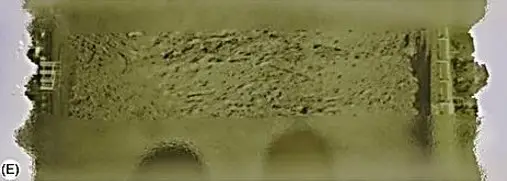
Source: Alison Harman wp
And this photo shows what the horse sees when its head is in a normal riding position.
Horse’s view with normal head position

The forward view is reduced as the head goes down
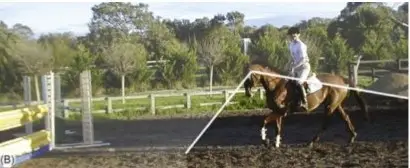
Jumpers need to have forward visibility
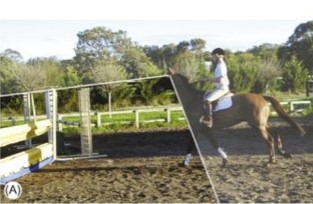
Source: Alison Harman wp
Attempts at (over) collection by the rider in front of the jump will prevent the horse from assessing what is needed. In terms of speed, leg placement and effort, which will decrease the jumping quality.
However, this is an action which is undertaken by virtually all riders. The main exceptions are riders who are having difficulty getting their horses to go forward. (i,e, naughty) And in these cases the horses usually end up going sideways, backwards or upwards.
By raising its head a horse uses vision to focus on distant objects
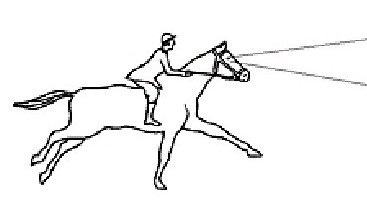
By holding its head more vertically a horse’s vision focusses on objects near its feet
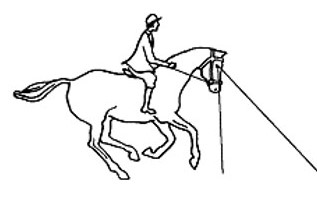
Source: Wikipedia.org. oa
More comments on the horse’s head position follow.
“Over-flexing the horse’s neck: A modern equestrian obsession?” by Paul D. McGreevy a, Alison Harman b, Andrew McLean c, Lesley Hawson a; a Faculty of Veterinary Science, University of Sydney, New South Wales, Australia; b Mount Hawthorn ESC, Mount Hawthorn, Western Australia, Australia; and c Australian Equine Behaviour Centre, Broadford, Victoria, Australia.
“When horses are grazing, the head is well in front of the vertical and the binocular field is directed toward the ground in front of the nose. However, with their laterally placed eyes, they have excellent, extensive lateral vision, which enables them to scan the environment in this position (Harman et al, 1999).
By contrast, when the horse is moving through space, it needs to use the binocular visual field, necessary for seeing in 3 dimensions. This field is located down the nose of the horse, not directly in front of the animal as it is in humans (Harman et al., 1999). This explains why the horses at liberty in the current series of photographs travel with the head well in front of the vertical.
The current trend for over-flexing the neck significantly compromises forward vision. This head position produces a horse that, because it cannot see in front, is rendered somewhat powerless. Which may be necessary for riders of modern, vigorous competition horses. It is clearly contraindicated in jumping horses in whom forward vision is crucial.
Hyperflexed horses are said to be showing signs of submission and ‘listening to their riders’. But it is possible that compromising a horse in this way makes it more reliant on the rider to avoid obstacles and such that it seems more biddable”.
The following photo shows how rollkur compromises forward vision.
Foreshortened Vision
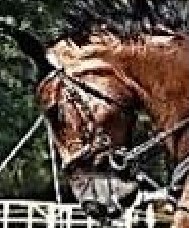
Source: nkc
Other factors affecting the horse’s vision
The horse’s eye characteristics as shown above prompt further questions as to how they are structured. Further extracts explain.
Range of vision
The following extract from Wikipedia describes the horse’s visual field.
“Horse eyes are among the largest of any land mammal, and are positioned on the sides of the head (that is, they are positioned laterally). This means horses have a range of vision of about 350°, with approximately 65° of this being binocular vision and the remaining 285° monocular vision. This provides a horse with the best chance to spot predators.”
“The horse’s wide range of monocular vision has two “blind spots,” or areas where the animal cannot see: in front of the face, making a cone that comes to a point at about 90–120 cm (3–4 ft) in front of the horse. And right behind its head, which extends over the back and behind the tail when standing with the head facing straight forward. Therefore, as a horse jumps an obstacle, it briefly disappears from sight right before the horse takes off”.
Monocular and Binocular field of vision described
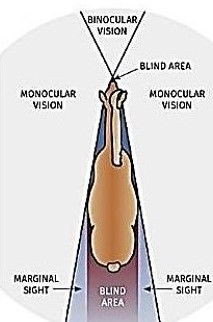
Source: veterian key; wb
The following extract from Wikipedia describes the horse’s visual field.
“Horse eyes are among the largest of any land mammal, and are positioned on the sides of the head (that is, they are positioned laterally). This means horses have a range of vision of about 350°, with approximately 65° of this being binocular vision and the remaining 285° monocular vision. This provides a horse with the best chance to spot predators.”
“The horse’s wide range of monocular vision has two “blind spots,” or areas where the animal cannot see: in front of the face, making a cone that comes to a point at about 90–120 cm (3–4 ft) in front of the horse. And right behind its head, which extends over the back and behind the tail when standing with the head facing straight forward. Therefore, as a horse jumps an obstacle, it briefly disappears from sight right before the horse takes off”.
The role of colour
The horse sees in black and white
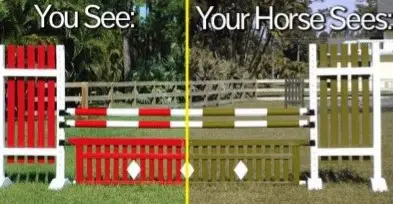
Source: sonaray.com.au: wp
How is the horse’s eye structured?
Wikipedia continues:
“The horse has a “visual streak”, or an area within the retina, linear in shape. there is a high concentration of ganglion cells (up to 6100 cells/mm2 in the visual streak compared to the 150 and 200 cells/mm2 in the peripheral area).
A retinal ganglion cell (RGC) is a type of neuron. It is located near the inner surface (the ganglion cell layer) of the retina of the eye. It receives visual information from photoreceptors via two intermediate neuron types: bipolar cells and retina amacrine cells.
Retinal ganglion cells process visual information that begins as light entering the eye. And transmit it to the brain via their axons, which are long fibers that make up the optic nerve. There are over a million retinal ganglion cells in the human retina. And they allow you to see as they send the image to your brain.
Horses have better acuity when the objects they are looking at fall in this region. Visual acuity (VA) is a measure of the ability of the eye to distinguish shapes and the details of objects at a given distance. They therefore will tilt or raise their heads, to help place the objects within the area of the visual streak.
The horse is very sensitive to motion, as motion is usually the first alert that a predator is approaching. Such motion is usually first detected in their periphery, where they have poor visual acuity. And horses will usually act defensive and run if something suddenly moves into their peripheral field of vision.”
The following image shows the horse’s “visual streak”. High concentrations are represented by the peaks.
Distribution of ganglion cells of a horse retina
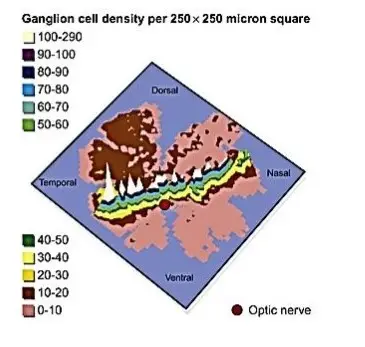
Source: Alison Harman-wp
Note-image is portrayed as if it were flat-mounted
The horse’s eye is one of the first ways it shows fear
Veterian Key explains:
“The exposition of more sclera is often noted in anxious animals because the eyes are opened wider to take in more visual information that may help them resolve the situation, while a fixed eye may be associated with reasonably chronic distress”.
Two of the most common characteristics for this situation are fear and pain. Examples are shown next.
Visible sclera is usually indicative of pain or fear
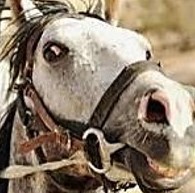
Source; canstockphoto.com
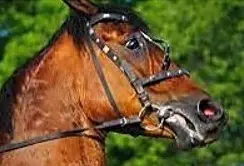
Source: writing of riding; 2enr
As the philosophy underpinning this blog is the creation of harmony between horse and rider, this situation of exposed sclera should be avoided.